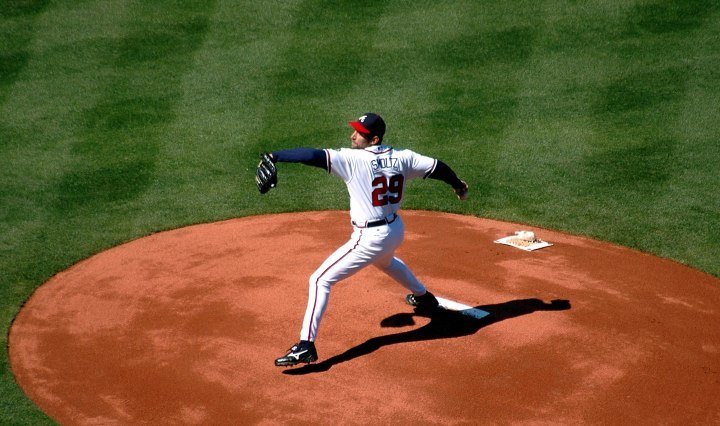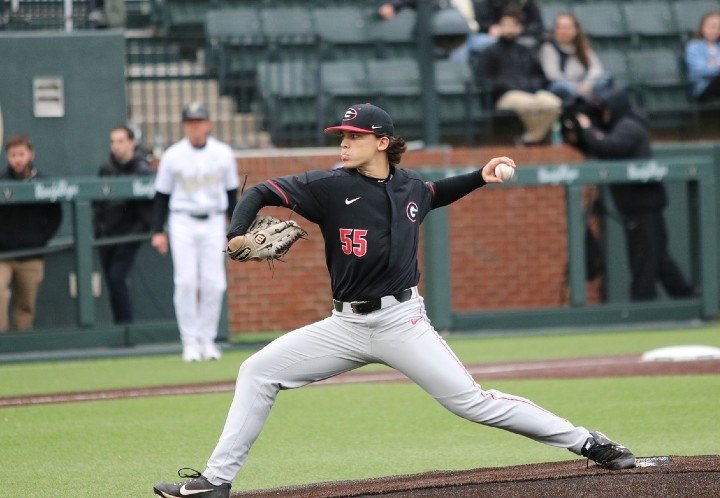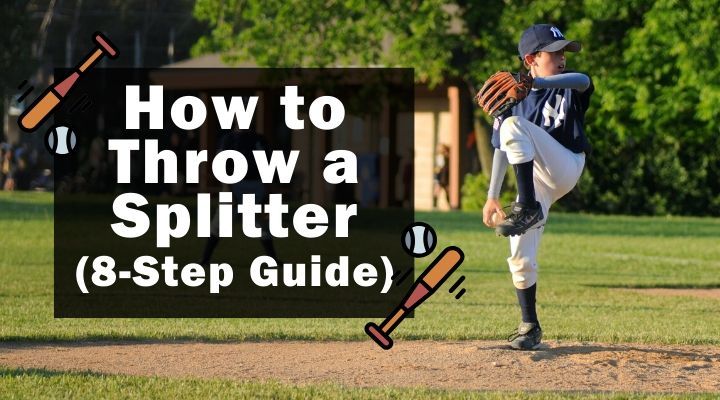The splitter, or split-finger fastball as it's also known, is one of the most devastating pitches in all of baseball.
It is such an effective pitch because it's thrown exactly like a fastball, and looks like a fastball out of the pitcher's arm, but basically "drops off the table" once it reaches the plate.
The sharp downward movement of the ball is very hard for a batter to predict because, unlike breaking balls, the ball doesn't spin any differently than a fastball.
Instead, it simply dies as it nears the plate, taking a hard dive down toward the dirt.
This effectiveness is why everyone should learn how to throw a splitter.
Because the pitch is thrown just like a fastball, it doesn't create any extra stress on a pitcher's arm, making it an ideal off-speed pitch for youth players in particular.
Along with a change-up, it is perhaps the "safest" pitch to throw other than a fastball.
The splitter is a pitch that is mainly used by pitchers who throw hard, but being a hard thrower is not a prerequisite for throwing the pitch.
In fact, the pitch was made popular in the 1970s by Bruce Sutter, a professional pitcher who learned how to throw it after he returned from having surgery because he didn't throw with as much velocity.
A splitter will often result in a swing-and-miss from the batter.
Those who are able to make contact with a splitter will often hit the ball on the ground, which results in the fielders being able to convert an out.
Let's take a step-by-step look at how to throw a splitter.
How to Throw a Splitter:
1. Start Your Grip Like a Fastball
As the full name of the pitch would suggest, the split-finger fastball is a type of fastball.
And, as you may expect, the grip of a splitter is pretty similar to that of a fastball, at least at the beginning.
The easiest way to grip a splitter is to place your fingers on the ball exactly the same way you would for a fastball.
Place your pointer finger and your middle finger on the top half of the ball, with the U-shaped part of the seam facing forward toward the plate.
Then, place your thumb at the bottom of the ball to give extra support.
2. Split Those Fingers Out
Once you have your fastball grip down, you only need to make a slight adjustment to grip the ball for a splitter.
All you have to do is spread your pointer finger and middle finger out so that you "split" the seam of the baseball.
Each of your fingers on top of the baseball should be on top of the seam on the outside of the ball.
Your two fingers will now make more of a U-shape than the typical V-shape that your fingers make when gripping a traditional fastball.
As with most pitches, it's very important that you shield the baseball in your glove from the batter.
It's very easy to spot the grip of a splitter, as there aren't too many other pitches where your fingers will be split apart that wide.
So make sure you work on your grip often before a game so that when you're in a game, you can hide the grip well.

3. Keep Your Wrist Stiff
When you're throwing a splitter, you want to avoid putting too much backspin on the ball.
Backspin will cause the pitch to stay up like a normal fastball would, instead of dropping down and out of the zone.
To do this, you want to keep your wrist stiffer than you would when you're throwing a fastball.
The grip is where you'll get the motion out of your hand that you need in order for the splitter to act properly.
4. Grip the Ball Loose
Even though you'll be keeping your wrist stiff when you're throwing a splitter, you need to make sure that you're gripping the ball pretty loose.
You want to imagine you're holding an egg in your hand.
If you grip it too hard, it'll break.
Doing this will allow the ball to release freely from your hand with just enough friction for that downward motion.
Gripping it too hard will put too much friction on the ball, which will result in an ineffective pitch.
5. Focus on the Mitt
Now that you have the grip of the splitter down, you want to prepare to throw it.
The first step in doing this is to know where to aim.
The easiest thing to do is to focus on the catcher's mitt when you're about to throw.
Aim as if you're throwing the pitch at the height of the catcher's mitt.
This will then allow your splitter the proper height it needs to drop off when it gets closer to the plate.
If you focus your eyes on where you want the pitch to end up -- near the dirt -- then it's likely you'll aim there.
This would then result in the pitch dropping off much earlier than you'd like, which will often result in a ball instead of a swing-and-miss.

6. Start Your Windup
Once you know where you want to aim, it's time to start your windup.
Your windup should be exactly the same for a splitter as it is for a fastball.
Simply step back off the mound with your lead foot, rotate your body halfway around, then break toward the plate.
7. Keep Your Elbow High
When you're in your windup, it's important that you keep your elbow on your throwing arm up high.
Ideally, you want your elbow to remain above your shoulder when you are releasing the baseball.
For example, if you're right handed, make sure your right elbow remains above your right shoulder as you release the pitch.
This will do two things:
(1) It'll help you avoid injury by putting less stress on your elbow and shoulder when you throw the ball.
(2) It'll make sure that the ball remains low when you release it.
The ball will have a tendency to go high out of your hand if your elbow is below your shoulder when you release it.
8. Release the Ball and Follow Through
While keeping your elbow high above your shoulder, bring your arm forward and get ready to release the ball.
The key to throwing a splitter is making sure that you release the ball when your hand is out front of your body.
You don't want to release the ball too early, as it will result in the pitch being thrown too high.
After you release, continue your throwing motion all the way through to the end.
Your throwing hand should be brought down across your opposite knee.
This will allow your body to absorb the energy your windup is creating, rather than having all of it fall on your elbow or shoulder.
This is a great way to reduce the chances of injury when throwing a splitter.
Common Issues When Throwing a Splitter
When you're first learning how to throw a splitter, you may come across some general issues in doing so.
Like any other pitch you're learning for the first time, you'll need to assess what is happening and then fix specific issues in either your grip, windup and/or release in order to troubleshoot it properly.
Here are some of the most common issues pitchers face when they first learn how to throw a splitter.
a. The splitter never drops off
Perhaps the most common issue pitchers face when learning to throw a splitter is they end up just throwing a regular fastball.
They think they are taking all the proper steps to throw a splitter, but then the pitch just ends up acting like a fastball when it comes out of their hand.
If this is happening to you, you want to check two things:
First, make sure that your fingers are the proper distance apart in your grip. They should both be positioned on top of the outside seam, which would make them roughly 1.5 to 2 inches apart from each other.
Second, make sure that you keep your wrist relatively stiff when you are gripping the ball. This will help change the outcome of the pitch from a fastball to a splitter.
b. The splitter drops off too early
Having the splitter drop off before the pitch even reaches the plate is another common issue pitchers face.
If this is happening to you, your fingers may actually be a little too far apart in your grip.
Try moving them a little closer together, but not too close.
Another reason for this issue could be that you're not throwing the ball hard enough.
Try adding a little more power when you throw the ball.
You don't want to overthrow it -- as that could result in injury -- but you want to make sure you are throwing a splitter with the same amount of thrust and power as you would your fastball.
c. The ball is spinning backward instead of sideways
The final common issue pitchers face when learning to throw a splitter is that the ball will have too much backspin.
If you'll recall, too much backspin will result in the pitch staying up in the zone as a fastball would, instead of dropping off.
The ideal spin on a splitter is actually sideways out of your hand. This will result in the ball dropping off as it gets closer to the plate.
If this is happening to you, you may want to try to hold the baseball deeper in your hand. This will put a little more friction on the ball and cause it to come out of your hand a different way.
Another thing you could try is spreading your index and middle fingers out a little more. Having them too close could actually cause that backspin to happen.
Conclusion
The splitter, or split-finger fastball, is a truly devastating pitch when executed properly.
It is thrown just like a fastball is, and it actually comes out of a pitcher's hand looking like a fastball, too, only to drop hard down just as the pitch is approaching the plate.
Many pitchers have used the splitter to create a lot of swing-and-misses or weak contact from batters.
If you learn how to throw this pitch properly, it could be a great addition to your arsenal.

